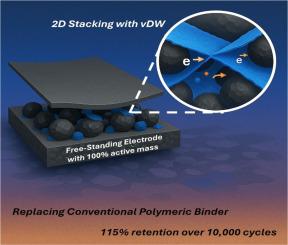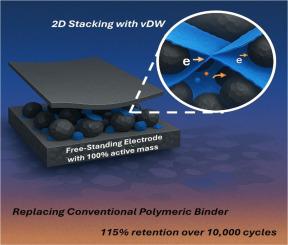Grinding-exfoliated 2D transition metal dichalcogenides as scalable binders for freestanding, additive-free electrodes
IF 5.6
3区 材料科学
Q1 ELECTROCHEMISTRY
引用次数: 0
Abstract
Polymeric binders are an essential component of electrode preparation; however, conventional binders can result in a loss of approximately 20 % to 40 % of the active electrode weight due to the addition of conductive additives and the polymer itself. 2D pseudocapacitive binders from the transition metal dichalcogenide (TMD) family (e.g., MoS2, MoSe2, WS2, WSe2) were introduced to address this. These materials also contribute to reduced NMP consumption during electrode fabrication. The sheet-like structure of exfoliated TMDs enables van der Waals interactions between adjacent layers, effectively binding active particles together while preserving the active surface area. Notably, the use of WSe2 as one of the TMD binders doubled the capacitance compared to conventional polymeric binders, achieving a high capacitance of 61.25 F g⁻¹ at 0.10 A g⁻¹ and delivering a power density of 2200 W kg⁻¹ at an energy density of 78 Wh kg⁻¹ for a freestanding electrode. This improvement is attributed to the pseudocapacitive nature of TMDs, which enhances charge storage. Furthermore, the WSe2 binder exhibited excellent cycling stability, retaining 115.73 % of its capacity at a high rate after 10,000 charge/discharge cycles, enabling faster charging. This work paves the way for utilizing other 2D materials as multifunctional binders for electrode preparation, driving the continued development of energy storage design.


研磨-剥落的二维过渡金属二硫族化物作为独立式无添加剂电极的可扩展粘合剂
聚合物粘合剂是电极制备的重要组成部分;然而,由于添加了导电添加剂和聚合物本身,传统的粘合剂会导致活性电极重量损失约20%至40%。为了解决这一问题,引入了过渡金属二硫化物(TMD)家族的2D假电容性结合剂(例如MoS2, MoSe2, WS2, WSe2)。这些材料也有助于减少电极制造过程中的NMP消耗。片状tmd的片状结构使相邻层之间的范德华相互作用,有效地将活性粒子结合在一起,同时保持活性表面积。值得注意的是,使用WSe2作为TMD粘合剂之一,与传统的聚合物粘合剂相比,电容增加了一倍,在0.10 a g⁻¹时达到61.25 F g⁻¹的高电容,在78 Wh kg⁻¹的能量密度下,提供2200 W kg的能量密度。这种改进归因于tmd的赝电容特性,它增强了电荷存储。此外,WSe2粘结剂表现出优异的循环稳定性,在10,000次充放电循环后仍能保持115.73%的高倍率容量,从而实现更快的充电。这项工作为利用其他二维材料作为电极制备的多功能粘合剂铺平了道路,推动了能量存储设计的持续发展。
本文章由计算机程序翻译,如有差异,请以英文原文为准。
求助全文
约1分钟内获得全文
求助全文
来源期刊

Electrochimica Acta
工程技术-电化学
CiteScore
11.30
自引率
6.10%
发文量
1634
审稿时长
41 days
期刊介绍:
Electrochimica Acta is an international journal. It is intended for the publication of both original work and reviews in the field of electrochemistry. Electrochemistry should be interpreted to mean any of the research fields covered by the Divisions of the International Society of Electrochemistry listed below, as well as emerging scientific domains covered by ISE New Topics Committee.
 求助内容:
求助内容: 应助结果提醒方式:
应助结果提醒方式:


